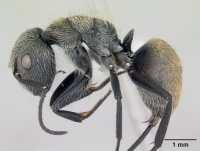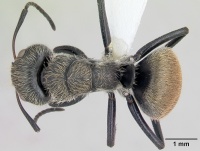Camponotus arboreus
| Camponotus arboreus | |
|---|---|

| |
| Scientific classification | |
| Kingdom: | Animalia |
| Phylum: | Arthropoda |
| Class: | Insecta |
| Order: | Hymenoptera |
| Family: | Formicidae |
| Subfamily: | Formicinae |
| Tribe: | Camponotini |
| Genus: | Camponotus |
| Species: | C. arboreus |
| Binomial name | |
| Camponotus arboreus (Smith, F., 1858) | |
| Synonyms | |
| |
Schmid et al. (2014) found this ant nesting in infructescences (the stem and remains of buds and fruits above the level of the water reservoir in the rosette) of the bromeliad Vriesea friburgensis on Santa Catarina Island, Brazil.
Identification
Distribution
Latitudinal Distribution Pattern
Latitudinal Range: -0.631944444° to -22.809943°.
| North Temperate |
North Subtropical |
Tropical | South Subtropical |
South Temperate |
- Source: AntMaps
Distribution based on Regional Taxon Lists
Neotropical Region: Argentina, Brazil (type locality), Ecuador, Panama, Paraguay.
Distribution based on AntMaps
Distribution based on AntWeb specimens
Check data from AntWeb
Countries Occupied
| Number of countries occupied by this species based on AntWiki Regional Taxon Lists. In general, fewer countries occupied indicates a narrower range, while more countries indicates a more widespread species. |

|
Estimated Abundance
| Relative abundance based on number of AntMaps records per species (this species within the purple bar). Fewer records (to the left) indicates a less abundant/encountered species while more records (to the right) indicates more abundant/encountered species. |

|
Biology
Castes
Nomenclature
The following information is derived from Barry Bolton's Online Catalogue of the Ants of the World.
- arboreus. Formica arborea Smith, F. 1858b: 44 (w.) BRAZIL (no state data).
- Type-material: syntype workers (number not stated).
- Type-locality: Brazil: (no further data).
- Type-depository: BMNH.
- [Note: Smith, F. 1858b: 45, says “several specimens… in Museum Collection”, and that one specimen is labelled “Island of Morajo, Brazil” (=Pará, Marajó I.).]
- Combination in Camponotus: Mayr, 1862: 666;
- combination in C. (Myrmobrachys): Kempf, 1965: 186.
- Junior synonym of femoratus: Forel, 1908c: 404.
- Status as species: Smith, F. 1862b: 29; Mayr, 1862: 666 (redescription); Roger, 1863b: 5, 44; Mayr, 1863: 398; Dalla Torre, 1893: 222; Forel, 1895b: 101; Emery, 1896d: 377 (in list); Forel, 1899c: 134; Emery, 1925b: 171; Borgmeier, 1927c: 161; Kempf, 1965: 186; Kempf, 1972a: 50; Bolton, 1995b: 86; Wild, 2007b: 27; Branstetter & Sáenz, 2012: 255; Mackay & Mackay, 2019: 752.
- Senior synonym of adpressisetosus: Kempf, 1965: 186; Kempf, 1972a: 50; Bolton, 1995b: 86.
- Distribution: Brazil, Colombia, Guatemala, Panama, Paraguay.
- adpressisetosus. Camponotus adpressisetosus Forel, 1879a: 101 (s.) BRAZIL (Bahia).
- Type-material: 2 syntype major workers.
- Type-locality: Brazil: Bahia (no collector’s name) (ex coll. H. de Saussure).
- Type-depository: MHNG.
- Mann, 1916: 480 (w.).
- Combination in C. (Myrmobrachys): Forel, 1914a: 270.
- Status as species: Dalla Torre, 1893: 220; Forel, 1895b: 101; Emery, 1896d: 377 (in list); Forel, 1904d: 177; Forel, 1912i: 79; Mann, 1916: 480 (redescription); Emery, 1925b: 162; Borgmeier, 1927c: 156.
- Junior synonym of arboreus: Kempf, 1965: 186; Kempf, 1972a: 50; Bolton, 1995b: 84.
Description
References
- Albuquerque, E., Prado, L., Andrade-Silva, J., Siqueira, E., Sampaio, K., Alves, D., Brandão, C., Andrade, P., Feitosa, R., Koch, E., Delabie, J., Fernandes, I., Baccaro, F., Souza, J., Almeida, R., Silva, R. 2021. Ants of the State of Pará, Brazil: a historical and comprehensive dataset of a key biodiversity hotspot in the Amazon Basin. Zootaxa 5001, 1–83 (doi:10.11646/zootaxa.5001.1.1).
- Bolton, B. 1995b. A new general catalogue of the ants of the world. Cambridge, Mass.: Harvard University Press, 504 pp. (page 86, catalogue)
- Kempf, W. W. 1965. Nota preliminar sôbre algumas formigas neotrópicas, descritas por Frederick Smith (Hymenoptera, Formicidae). Rev. Bras. Biol. 25: 181-186 (page 186, combination in C. (Myrmobrachys), and senior synonym of adpressisetosus)
- Mayr, G. 1862. Myrmecologische Studien. Verh. K-K. Zool.-Bot. Ges. Wien 12: 649-776 (page 66, combination in Camponotus)
- Schmid V.S., Langner S., Steiner J. and Zillikens A. 2014. Inflorescences of the Bromeliad Vriesea friburgensis as Nest Sites and Food Resources for Ants and Other Arthropods in Brazil. Psyche. 2014:Article ID 396095. 9 pp. doi:10.1155/2014/396095
- Smith, F. 1858b. Catalogue of hymenopterous insects in the collection of the British Museum. Part VI. Formicidae. London: British Museum, 216 pp. (page 44, worker described)
- Ulysséa, M.A., Brandão, C.R.F. 2013. Ant species (Hymenoptera, Formicidae) from the seasonally dry tropical forest of northeastern Brazil: a compilation from field surveys in Bahia and literature records. Revista Brasileira de Entomologia 57, 217–224 (doi:10.1590/s0085-56262013005000002).
References based on Global Ant Biodiversity Informatics
- Antoniazzi R., R. N. S. L. Garoo, W. Dattilo, S. P. Ribeiro, and F. S. Neves. 2019. Ant species richness and interactions in canopies of two distinct successional stages in a tropical dry forest. The Science of Nature 106: 20
- Costa-Milanez C. B., G. Lourenco-Silva, P. T. A. Castro, J. D. Majer, and S. P. Ribeiro. 2014. Are ant assemblages of Brazilian veredas characterised by location or habitat type? Braz. J. Biol. 74(1): 89-99.
- Fernández, F. and S. Sendoya. 2004. Lista de las hormigas neotropicales. Biota Colombiana Volume 5, Number 1.
- Fleck M. D., E. Bisognin Cantarelli, and F. Granzotto. 2015. Register of new species of ants (Hymenoptera: Formicidae) in Rio Grande do Sul state. Ciencia Florestal, Santa Maria 25(2): 491-499.
- Gallego-Ropero M.C., R.M. Feitosa & J.R. Pujol-Luz, 2013. Formigas (Hymenoptera, Formicidae) Associadas a Ninhos de Cornitermes cumulans Kollar (Isoptera, Termitidae) no Cerrado do Planalto Central do Brasil. EntomoBrasilis, 6(1): 97-101.
- Gomes E. C. F., G. T. Ribeiro, T. M. S. Souza, and L. Sousa-Souto. 2014. Ant assemblages (Hymenoptera: Formicidae) in three different stages of forest regeneration in a fragment of Atlantic Forest in Sergipe, Brazil. Sociobiology 61(3): 250-257.
- Kempf W. W. 1965. Nota preliminar sôbre algumas formigas neotrópicas, descritas por Frederick Smith (Hymenoptera, Formicidae). Revista Brasileira de Biologia 25: 181-186.
- Kempf, W.W. 1972. Catalago abreviado das formigas da regiao Neotropical (Hym. Formicidae) Studia Entomologica 15(1-4).
- Neves F. S., K. S. Queiroz-Dantas, W. D. da Rocha, and J. H. C. Delabie. 2013. Ants of Three Adjacent Habitats of a Transition Region Between the Cerrado and Caatinga Biomes: The Effects of Heterogeneity and Variation in Canopy Cover. Neotrop Entomol 42: 258268.
- Neves F. S., R. F. Braga, M. M. do Espirito-Santo, J. H. C. Delabie, G. Wilson Fernandes, and G. A. Sanchez-Azofeifa. 2010. Diversity of Arboreal Ants In a Brazilian Tropical Dry Forest: Effects Of Seasonality and Successional Stage. Sociobiology 56(1): 1-18.
- Nunes F. A., G. B. Martins Segundo, Y. B. Vasconcelos, R. Azevedo, and Y. Quinet. 2011. Ground-foraging ants (Hymenoptera: Formicidae) and rainfall effect on pitfall trapping in a deciduous thorn woodland (Caatinga), Northeastern Brazil. Rev. Biol. Trop. 59 (4): 1637-1650.
- Oliveira-Santos L. G. R., R. D. Loyola, A. B. Vargas. 2009. Canopy Traps: a Technique for Sampling Arboreal Ants in Forest Vertical Strata. Neotropical Entomology 38(5):691-694.
- Pires de Prado L., R. M. Feitosa, S. Pinzon Triana, J. A. Munoz Gutierrez, G. X. Rousseau, R. Alves Silva, G. M. Siqueira, C. L. Caldas dos Santos, F. Veras Silva, T. Sanches Ranzani da Silva, A. Casadei-Ferreira, R. Rosa da Silva, and J. Andrade-Silva. 2019. An overview of the ant fauna (Hymenoptera: Formicidae) of the state of Maranhao, Brazil. Pap. Avulsos Zool. 59: e20195938.
- Ribas C. R., J. H. Schoereder, M. Pic, and S. M. Soares. 2003. Tree heterogeneity, resource availability, and larger scale processes regulating arboreal ant species richness. Austral Ecology 28(3): 305-314.
- Ribas C. R., and J. H. Shoereder. 2007. Ant communities, environmental characteristics and their implications for conservation in the Brazilian Pantanal. Biodivers. Conserv. 16: 1511-1520.
- Schmid V. S., S. Langner, J. Steiner, and A. Zillikens. 2014. Inflorescences of the Bromeliad Vriesea friburgensis as Nest Sites and Food Resources for Ants and Other Arthropods in Brazil. Psyche http://dx.doi.org/10.1155/2014/396095
- Ulyssea M. A., and C. R. F. Brandao. 2013. Ant species (Hymenoptera, Formicidae) from the seasonally dry tropical forest of northeastern Brazil: a compilation from field surveys in Bahia and literature records. Revista Brasileira de Entomologia 57(2): 217224.
- Ulyssea M.A., C. E. Cereto, F. B. Rosumek, R. R. Silva, and B. C. Lopes. 2011. Updated list of ant species (Hymenoptera, Formicidae) recorded in Santa Catarina State, southern Brazil, with a discussion of research advances and priorities. Revista Brasileira de Entomologia 55(4): 603-611.
- Ulysséa M. A., C. R. F. Brandão. 2013. Ant species (Hymenoptera, Formicidae) from the seasonally dry tropical forest of northeastern Brazil: a compilation from field surveys in Bahia and literature records. Revista Brasileira de Entomologia 57(2): 217-224.

